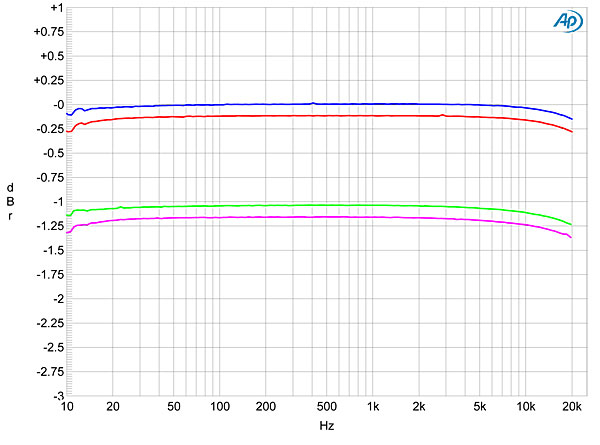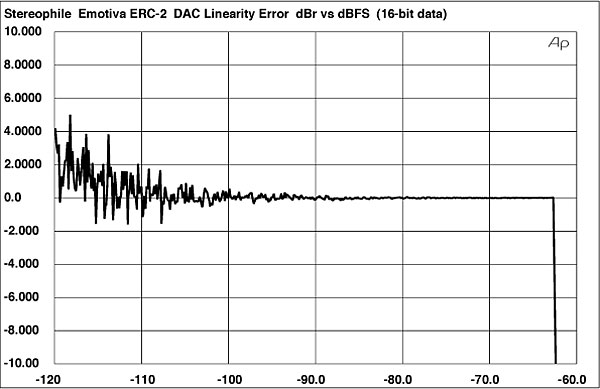| Columns Retired Columns & Blogs |
Am I the only one to see this player bears more than a passing resemblance with the Electrocompaniet products?
I ran the review sample of the Emotiva ERC-2 CD player through my usual test regime. To measure the ERC-2, I used Stereophile's loan sample of the top-of-the-line Audio Precision SYS2722 system (see www.ap.com and the January 2008 "As We See It" for some tests, I also used my vintage Audio Precision System One Dual Domain and the Miller Audio Research Jitter Analyzer.
The maximum output level from both the ERC-2's balanced and single-ended outputs was 2.25V, which is 1dB higher than the CD standard's 2V. If not accounted for, this will tilt A/B comparisons in the Emotiva's favor. Both outputs inverted absolute polarity—another factor that will influence comparisons if not taken into account—and the output impedance was 609 ohms from the single-ended RCA jacks, 1214 ohms from the balanced XLRs. These figures were taken at 1 and 20kHz; at 20Hz, they rose to 625 and 1256 ohms, respectively, which should have no subjective consequences.
The ERC-2's error correction/concealment was the best I have encountered in more than 20 years of testing CD players. It played every track on the Pierre Verany Test CD, which has calibrated gaps in its data spiral, without dropouts, glitches, or any errors being flagged in the digital output stream. This includes the torture test, in which 4mm gaps in the data spiral are combined with minimum track pitch. The only oddity I found was that the Validity flag in the datastream's auxiliary code was permanently set to a value of 1, which suggests corrupt data. However, this didn't appear to affect the integrity of the ERC-2's digital output.
The Emotiva's frequency response was flat within the audioband with both normal data (fig.1, blue and red traces) and pre-emphasized data (green and magenta). Channel separation (Fig.2) was superb, at >120dB in both directions below 1kHz, and still 103dB at 20kHz.


Analyzing the spectrum of the ERC-2's output with a swept 1/3-octave bandpass filter while the player decoded dithered data representing a 1kHz tone at –90dBFS (fig.3) revealed minimal linearity error and a complete absence of power-supply–related or harmonic spuriae; in fact, all that can be seen in this graph is the spectrum of the dither noise used to encode the signal. Repeating the analysis with an FFT technique gave a similar picture (fig.4). Plotting the linearity error against absolute error again gave a trace dominated by dither (fig.5), the ERC-2's noise floor being below the 16-bit dither level. As a result, the Emotiva's reproduction of an undithered tone at exactly –90.31dBFS was excellent, the three DC voltage levels described by the data being well defined and symmetrical about the time axis (fig.6).




Harmonic distortion with full-scale signals was low, even into the punishing 600 ohm load (fig.7), with the third harmonic the highest in level. However, this graph shows that, although they are very low in level, some high-order harmonic spuriae are present. While low-order intermodulation distortion was very low, the difference product from an equal full-scale mix of 19 and 20kHz tones lies at –108dB, the higher-order products lie at –72dB (fig.8), and a curious rise in the noise floor is evident to either side of the primary tones.


This modulation of the noise floor can also be seen in the spectrum of the ERC-2's output while it decoded the 16-bit J-Test signal (fig.9), and is very similar to that produced by a chipset from the Finnish company Sample Rate Systems, which used to be ubiquitous in first- and second-generation DVD players. While data-related jitter sidebands in fig.9 are absent or obscured by the rise in the noise floor, a regular series of sidebands spaced at the power-supply frequency of 60Hz is visible. The Miller Analyzer calculated these sidebands to be equivalent to 1200 picoseconds of jitter, which is moderately high.

Other than its somewhat compromised jitter performance and curious noise-floor modulation at high frequencies, Emotiva's ERC-2 measures very well.—John Atkinson

Am I the only one to see this player bears more than a passing resemblance with the Electrocompaniet products?

Are you really whining about a $449 cd player made in China?

Buy American. Buy Canadian. Just don't need any more startups handing large amounts of our cash to China while scraping of their percentage. It's a free market. If people want to send the rewards of their hard labor overseas to satisfy desire and short-sighted greed, so be it. It should be called what it is, though.

I understand your desire to purchase North American goods. Last year I bought my first American vehicle- a Ford Focus. Love the car. While that car is produced in North America, it is made of components that are manufactured in China. Many manufacturers today rely on a global supply chain that blurs notions of national identities.
Emotiva is no different. They have headquarters in Tennessee that employs Americans. Check their website right now, and you'll find two positions available. Their business model is commendable. Offer great sounding components that real people can afford, made possible by American engineering, design and customer service coupled with efficient Chinese manufacturing and a direct to consumer sales model. That's what made those two jobs being offered in Tennessee possible.

A handful of people are skimming a small percentage off of the money cheap consumers seem all to willing to send overseas. Wouldn't it be better to add a factoryworth of (hopefully union-free) jobs for skilled Americans? Short sighted and greedy.

> Because I am an audiophile, I want to hear that music through the best possible source component
If the author wanted to hear music through the best possible source component, he wouldn't be listening to low-resolution CDs, still stuck at 44.1 kHz sampling. This machine can't even play hi-rez SACDs. History. Time to move on to hi-rez.